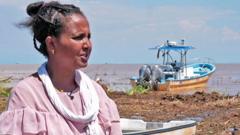In a heart-wrenching story emerging from the shores of Lake Turkana, Senait Mebrehtu, a grieving mother, commemorated her daughter, Hiyab, who tragically drowned while attempting to migrate into Kenya through perilous smuggling routes. Hiyab, just 14 years old, was among a group of migrants navigating the expansive and tumultuous waters of the lake when their boat capsized. As winds picked up overnight, Hiyab's sister managed to cling to hope and survival amid the chaos, but the tragedy struck deep within their family.
Senait had fled Eritrea with two younger children three years prior, escaping a regime notorious for its brutal military conscription. She openly expressed anger at the smugglers, proclaiming that had they informed her about the lake's dangers, she would never have allowed her daughters to undertake such a risky journey. Saints and devout individuals have often found themselves in a desperate predicament, seeking asylum far from oppressive regimes.
The increasing tensions in the region combined with strict patrols on traditional routes have pushed traffickers to resort to Lake Turkana, which is becoming well-known as an “illegal crossing” point for migrants. A trafficker confirmed the transition to this new route, revealing that the dynamics of smuggling networks have adapted to a complex web of challenges faced by desperate families. As they navigate their journey from Eritrea through Ethiopia and into Kenya, many find themselves trapped in a cycle of exploitation.
Visiting the site of her daughter's death, Senait learned from others who witnessed the tragic mishap. Eyewitness accounts revealed the boat, overloaded with up to 20 passengers, struggled to stay afloat and ultimately capsized. Despite the scoffing warnings against their practices, smugglers continue to lure families, exploiting their hopes for a better life.
This situation reflects broader issues, as violence in neighboring nations has escalated and pressurized refugees to travel over increasingly dangerous paths. With an estimated 345,000 Eritrean refugees in East Africa alone, the desperation for safety is palpable.
Local fishermen have reported grim discoveries of bodies washing ashore, further underscoring the true toll of this perilous migration route. As this heartbreaking narrative unfolds, Ms. Senait holds onto hope, sorrowful for her daughter while feeling blessed for her surviving child.
Despite the betrayal and exploitation that so many migrants face, the smuggling networks continue to thrive, leading to questions about international awareness and intervention as this multifaceted crisis deepens in East Africa.
Senait had fled Eritrea with two younger children three years prior, escaping a regime notorious for its brutal military conscription. She openly expressed anger at the smugglers, proclaiming that had they informed her about the lake's dangers, she would never have allowed her daughters to undertake such a risky journey. Saints and devout individuals have often found themselves in a desperate predicament, seeking asylum far from oppressive regimes.
The increasing tensions in the region combined with strict patrols on traditional routes have pushed traffickers to resort to Lake Turkana, which is becoming well-known as an “illegal crossing” point for migrants. A trafficker confirmed the transition to this new route, revealing that the dynamics of smuggling networks have adapted to a complex web of challenges faced by desperate families. As they navigate their journey from Eritrea through Ethiopia and into Kenya, many find themselves trapped in a cycle of exploitation.
Visiting the site of her daughter's death, Senait learned from others who witnessed the tragic mishap. Eyewitness accounts revealed the boat, overloaded with up to 20 passengers, struggled to stay afloat and ultimately capsized. Despite the scoffing warnings against their practices, smugglers continue to lure families, exploiting their hopes for a better life.
This situation reflects broader issues, as violence in neighboring nations has escalated and pressurized refugees to travel over increasingly dangerous paths. With an estimated 345,000 Eritrean refugees in East Africa alone, the desperation for safety is palpable.
Local fishermen have reported grim discoveries of bodies washing ashore, further underscoring the true toll of this perilous migration route. As this heartbreaking narrative unfolds, Ms. Senait holds onto hope, sorrowful for her daughter while feeling blessed for her surviving child.
Despite the betrayal and exploitation that so many migrants face, the smuggling networks continue to thrive, leading to questions about international awareness and intervention as this multifaceted crisis deepens in East Africa.



















